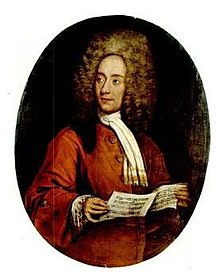Tomaso Albinoni

Tomaso Giovanni Albinoni (8 June 1671 – 17 January 1751) was a Venetian composer. He wrote operas and instrumental music. He is best remembered as the composer of a work called "Adagio in G Minor". Albinoni did not actually write the Adagio.[1]
Life[change | change source]
Albinoni was born in Venice. He learned to play the violin and to sing. It is not known who his teachers are. His first opera, Zenobia, regina de Palmireni, was performed in Venice in 1694.[2]
In 1705, he married Margherita Rimondi, a soprano singer.
He became famous and he performed his operas in many Italian cities, including Venice, Genoa, Bologna, Mantua, Udine, Piacenza, and Naples. He also wrote and published instrumental music during this time. Albinoni did not try to find a job in a church or a court. He remained an independent composer and published music on his own.
He retired from writing music after 1741, and died in Venice in 1751.
Music[change | change source]
Most of Albinoni's operas are lost. This is because he did not publish his operas during his life. His instrumental music has survived. Nine collections of instrumental music were published. Because of this, he is better known for writing instrumental music today. He is the first Italian composer to publish an oboe concerto.[3]
He was known by Johann Sebastian Bach, who wrote at least two fugues based on themes by Albinoni.
References[change | change source]
- ↑ Lugert, Wulf Dieter; Schütz, Volker (February 1998). "Adagio à la Albinoni". Praxis des Musikunterrichts. 53: 15.
- ↑ Talbot, Michael (2001). "Albinoni, Tomaso Giovanni". Grove Music Online (8th ed.). Oxford University Press.
- ↑ Buelow, George J. (2004). A History of Baroque Music. Indiana University Press. p. 467. ISBN 978-0-253-34365-9.
